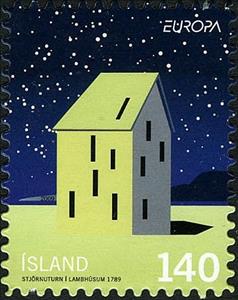Stamp: EUROPA / C.E.P.T.: international year of astronomy (Iceland 2009)
EUROPA / C.E.P.T.: international year of astronomy (Iceland 2009)
07 May (Iceland ) within release Europa Astronomy goes into circulation Stamp EUROPA / C.E.P.T.: international year of astronomy face value 140 Icelandic króna
| Stamp EUROPA / C.E.P.T.: international year of astronomy in catalogues | |
|---|---|
| Michel: | Mi:IS 1245 |
| Stamp Number: | Sn:IS 1172 |
Stamp is square format.
Also in the issue Europa Astronomy:
- Booklet - Booklet of 10, Observatory face value 1400;
- Stamp - EUROPA / C.E.P.T.: international year of astronomy face value 140;
- Stamp - EUROPA / C.E.P.T.: international year of astronomy face value 105;
- Stamp - EUROPA / C.E.P.T.: international year of astronomy face value 105;
- Booklet - Booklet of 10, Sun and shadows at different times face value 1050;
- Stamp - EUROPA / C.E.P.T.: international year of astronomy face value 140;
Stamp EUROPA / C.E.P.T.: international year of astronomy it reflects the thematic directions:
The European Conference of Postal and Telecommunications Administrations (CEPT) was established on June 26, 1959, as a coordinating body for European state telecommunications and postal organizations. The acronym comes from the French version of its name Conférence européenne des administrations des postes et des télécommunications.
The Europa postage stamp (also known as Europa - CEPT until 1992) is an annual joint issue of stamps with a common design or theme by postal administrations of member countries of the European Communities (1956-1959), the European Conference of Postal and Telecommunications Administrations (CEPT) from 1960 to 1992, and the PostEurop Association since 1993. Europe is the central theme. EUROPA stamps underlines cooperation in the posts domain, taking into account promotion of philately. They also build awareness of the common roots, culture and history of Europe and its common goals. As such, EUROPA stamp issues are among the most collected and most popular stamps in the world. Since the first issue in 1956, EUROPA stamps have been a tangible symbol of Europe’s desire for closer integration and cooperation.
Astronomy is a natural science that studies celestial objects and the phenomena that occur in the cosmos. It uses mathematics, physics, and chemistry in order to explain their origin and their overall evolution. Objects of interest include planets, moons, stars, nebulae, galaxies, meteoroids, asteroids, and comets. Relevant phenomena include supernova explosions, gamma ray bursts, quasars, blazars, pulsars, and cosmic microwave background radiation. More generally, astronomy studies everything that originates beyond Earth's atmosphere. Cosmology is a branch of astronomy that studies the universe as a whole. .
An observatory is a location used for observing terrestrial, marine, or celestial events. Astronomy, climatology/meteorology, geophysics, oceanography and volcanology are examples of disciplines for which observatories have been constructed




